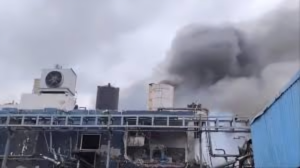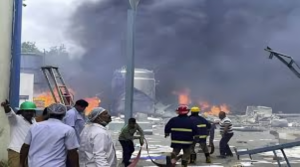Sivakasi Firecracker Unit Blast: Ongoing Explosions Spark Safety Concerns
Introduction
On June 30, 2025, a devastating explosion ripped through a firecracker manufacturing unit in Sivakasi, a town in Tamil Nadu renowned for its fireworks industry. Initial reports suggest multiple casualties and injuries, as the blast was powerful enough to shake nearby buildings. Rescue teams continue to work amid intermittent detonations, complicating relief efforts. This incident highlights longstanding safety challenges in the region’s pyrotechnics sector and raises urgent questions about regulatory oversight and worker protection.

Background of Sivakasi’s Firecracker Industry
Sivakasi has been India’s firecracker hub for over a century, supplying festive fireworks across the nation. The town’s economy relies heavily on small- and medium-sized units, many of which operate with limited automation and safety infrastructure. Seasonal demand, especially around Diwali, drives units to increase production—even at the expense of established safety norms. Over the years, numerous minor accidents have been reported, but significant regulatory reforms have been slow to materialize.
Key Factors Contributing to the Blast
- Outdated Facilities and Equipment
Many units use aging machinery prone to sparks and friction—primary ignition sources in firecracker production. - Inadequate Training and Overworked Staff
Workers, often from economically vulnerable backgrounds, receive minimal formal training on handling explosive materials. Long hours to meet high demand can lead to fatigue and lapses in caution. - Lax Enforcement of Safety Protocols
Regular inspections and safety audits are sporadic. Compliance with storage limits for gunpowder and other chemicals is frequently overlooked. - Poor Emergency Preparedness
Lack of clear evacuation routes, limited firefighting equipment on-site, and minimal coordination with local fire services exacerbate the impact when accidents occur.
Immediate Aftermath and Response
Local authorities responded swiftly to the scene, with fire tenders and ambulances arriving within the first hour. However, the ongoing detonations inside the premises forced teams to establish a safety perimeter, delaying medical evacuation of the injured. Hospitals in Virudhunagar and neighboring districts have been put on alert. Community volunteers are assisting with first aid and crowd control.
Long-Term Implications for Worker Safety
The recurring nature of such incidents demands a comprehensive overhaul of safety standards across Sivakasi’s fireworks industry. Key measures should include:
- Mandatory Safety Training
– Accredited certification programs for all workers.
– Regular drills simulating blast scenarios. - Modernization of Infrastructure
– Transition to automated or semi-automated production lines equipped with spark detectors.
– Upgraded storage facilities with temperature and humidity controls. - Strengthened Regulatory Framework
– More frequent and unannounced inspections by the State Explosives Department.
– Strict penalties for units found violating safety norms. - Community and Stakeholder Engagement
– Formation of local safety committees including factory owners, workers’ representatives, and government officials.
– Public awareness campaigns on safe handling and first-response actions.
Real-Life Example: Lessons from the 2019 Incident
In 2019, a similar explosion at a nearby fireworks factory resulted in ten fatalities. Post-incident investigations revealed that though the plant had been cited for safety violations months earlier, no follow-up action was taken. Subsequent legal proceedings led to fines, but the underlying systemic issues remained unaddressed. This repeat tragedy underscores the necessity for not only punitive measures but also sustained capacity-building initiatives within the workforce and management.
Conclusion
The Sivakasi blast is a stark reminder of the precarious balance between industrial production and worker safety. While the fireworks sector fuels vibrant celebrations nationwide, it must prioritize human lives over output. Immediate relief efforts are vital, but long-term structural changes—including rigorous training, infrastructure upgrades, and robust enforcement—are indispensable to prevent future disasters. Stakeholders at every level must collaborate to ensure that Sivakasi’s legacy of light and color does not continue to come at a fatal cost.
